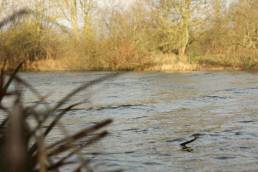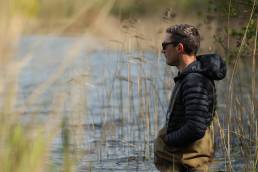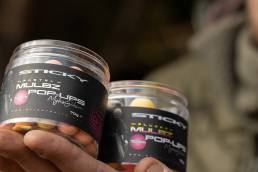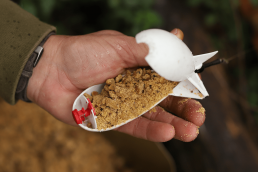
Luke Stevenson discusses the merits of Chod fishing, a forgotten art that works incredibly well on weedy, silty venues
Luke Stevenson discusses the merits of Chod fishing, a forgotten art that works incredibly well on weedy, silty venues
When targeting big carp, I always revert to my favourite method of catching them which is using Chods/Hinges over a spread of boilies. It’s a form of angling that has disappeared to some extent with the rise in popularity of new rigs such as the Spinner, but I’ve always stuck to my guns and trusted what has caught some lovely carp. If it isn’t broke, why change something which you have utmost confidence in? For me, the more people that follow the trends and lead themselves down the same rabbit hole, it only makes my angling more effective as the carp can soon wise up to certain tactics.



The art of Chod fishing relies on a variety of factors, but the main one is the venue has to suit them, i.e., the substrate you’re going to present on. Being a very discreet way of angling, I know I can pretty much present on anything that’s in front of me, without worrying about fishing to a clip or a certain area which may have a ‘spot’. It’s a case of letting the carp do the talking and fishing to what you see. In essence, I’m not looking for a clean, polished gravel spot to present on, I look for a half-decent drop amongst carp activity that I have either witnessed right there and then or on a previous session if there’s nothing happening visually at the time.
To make it simpler in word format, I think it’s a great opportunity to break each aspect down and explain in detail:
CHODS V HINGES
CHODS V HINGES
This year I’ve been focusing on a venue which is very weedy, and if the carp are amongst the thicker weed, then a Chod is, in my opinion, the only option. I would use a hinge on areas which aren’t choked with weed, but are clean enough to allow a hooklink to settle amongst the substrate. If I do decide to fish to a spot which I have been baiting and hitting the clip as such, I’ll ditch the Chod in favour of the Hinge completely. So, in short, Hinges are reserved for spots I know, and Chods are for spots I don’t know.

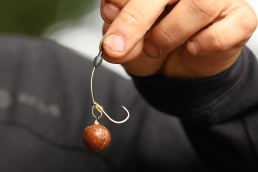
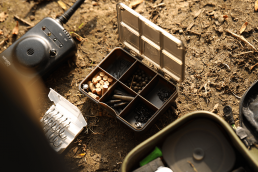
THE BAITING SITUATION
THE BAITING SITUATION
When fishing for drops, the aim is to judge the presentation on the feeling transmitted through the rod, then with minimal effort, bait around the area with washed-out boilies. It’s nothing new of course, but when you’re looking to establish a bait in an area, I think washing them out to give a paler appearance is a great edge to have. The baits become very soft and super-digestible, whilst retaining a lot of attraction due to the added LO30-T I like to use. Not only do the boilies become more appealing to the carp, but they also become very heavy, allowing them to be used with my favoured method of bait application; the catapult. It’s the perfect approach for the intimate waters I am currently targeting, as it allows me to fish up to around 60 yards.





Take some standard 16mm Krill out of the freezer

Get them straight into the bucket
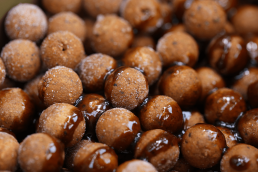
Drizzle a good helping of L-Zero-30-T onto the boilies

Boil the kettle

Add boiling water to the bait

Leave to rest and allow them to soften overnight whilst soaking the oily goodness from the liquid
When it comes to the Krill Active, I reserve it for two different scenarios the first is for clearing a spot. The fine particles that come off the baits help get the fish grubbing around a bit more than normal boilies, which causes them to clear spots much faster. The second scenario would be to fire up the activity in my swim quickly, for instance if I feel I should have had a bite, but haven’t, I add some Krill Active to try and induce a bite. I always carry some with me, normally in 12mm, as it always comes in handy.
KEEPING MOBILE
KEEPING MOBILE
I’ve never been someone who takes a lot of gear, as I simply don’t feel the need to with the style of angling I do. My fishing is all about being reactive and as such my approach is tailored towards speed and efficiency. I can be on the barrow or walking with rods and a rucksack in an instant with minimal gear to pack up and no rig complications clouding my judgement. I can remain comfortable with what I have, but also ensure the focus is on the location. My rucksack holds everything I need for a few days angling, whilst a lightweight brolly and bed see me through the hours of darkness when the time comes to set up. A small lead pouch with the smaller sizes I prefer is tucked in the rucksack, along with a very minimal, small pouch with all the terminal bits I need to whip up another Chod if necessary.
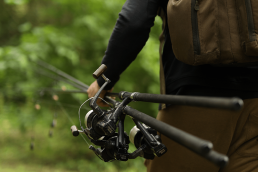


SETTING UP THE NAKED CHOD
SETTING UP THE NAKED CHOD
My preferred way of fishing Naked Chods is with a fluorocarbon mainline. This enables the line concealment to be as good as possible, whilst also retaining very little stretch to help feel for the drops. I then have a naked buffer bead on the line, followed by the running Chod, down to a small leadcore leader with a drop off system like a Heli Safe to ensure the lead is gone on the take.
The short piece of leadcore is very different to how most people set up the Naked Chod, which more often fished on the main line straight through. I prefer to fish them this way to stop the Chod section going near the lead system on the drop. It means you always have around 12 inches of line to allow the Chod to settle on wherever it lands. The bead between the fluorocarbon and the leader then acts as a buffer, whilst also covering the knot which attaches the line to the leadcore. This then slides down when playing a carp and the leadcore withstands the pressure of the fight much more than the line would itself on a traditional Naked setup.
On the business end, I use a super-sharp hook to give me the best possibility of converting a pickup into a bite, along with a 15mm hand-rolled Krill cork ball pop-up. I make those myself but more recently I’ve used some which are rolled by my mate Mark at Koda Pops. If I haven’t got the time to do them myself, he uses the exact ingredients from Sticky to roll them, and that for me is vitally important and it saves me having to get all my bait making equipment out. My confidence with The Krill stems back years, and I certainly wouldn’t want anything else on the hook than a match the hatch pop-up, it’s done me proud over the years.


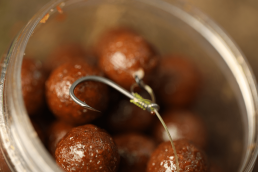
EFFORT EQUALS REWARD
EFFORT EQUALS REWARD
I guess this would be an accumulation of the above, as each little aspect contributes into the bigger picture. By having full confidence in your bait and tactics, you can channel the majority of your efforts into things like location, watching the water and looking for feeding signs. A lot of lakes come alive at first light, and I often take a short stroll down the bank with the receiver (as long as it’s not snaggy) to check areas and look for any new opportunities. Consistency is key, and if you can get into a routine, you may feel drained at times with minimal sleep, but I can guarantee you, you’ll spot far more in comparison to just scrolling your phone when you wake up or having a lie in.
There’s no doubt that other rigs will catch you fish in the same scenario as the above, but for me it’s all about confidence. A confident angler is a dangerous one, and if you can get in that mindset in your angling, I have no doubt that the results will follow suit.







